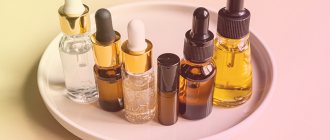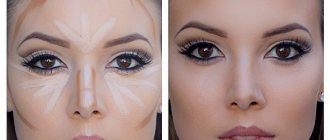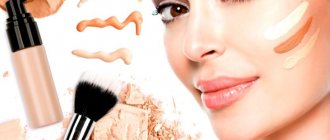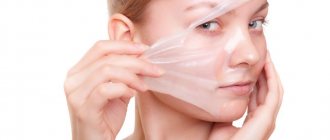In winter, the skin is exposed to the negative effects of wind and cold, resulting in flaking, redness and a feeling of tightness, the skin becomes dry, which makes it vulnerable to allergens, bacteria and viruses. In order to prepare your skin for frost, you must follow the rules of winter care.
Winter facial skin care - rules and mistakes
Not many people know what the basics of proper care should be, and they make mistakes, causing even more harm. Among the main errors it should be noted:
- inconsistency of care products with skin type - many people believe that in winter the skin type changes, in fact this is not so - the dermis simply becomes drier, which requires adjustments to usual care;
- insufficient hydration - there is a common misconception that moisturizing creams should not be used in winter, since the water in them freezes in the cold and harms the skin, this is not true - not only the skin, but also the air in the room should be moisturized;
- hot shower/wash - it is recommended to use warm water, since higher temperatures destroy the lipid barrier and lead to dehydration;
- aggressive peelings and alcohol-based cleansers - in winter they should be replaced with softer ones marked “for sensitive skin”;
- classic two-time care - in winter, the skin needs protection before each exit; creams should be applied no later than 20 minutes before going out;
- superficial care - when caring for your skin using cosmetic products, you should remember the need for proper nutrition and maintaining a water-salt balance.
How to take care of your skin from the inside
It is necessary to take care of your facial skin not only from the outside, with the help of cosmetics, but also from the inside, with the help of a well-balanced diet. What we drink and eat has a huge impact on the condition of our skin, so the first place to start is to pay attention to your eating habits.
Drink plenty of water
The human body is on average 70% water. Without maintaining the body's water balance, it is impossible to imagine its normal functioning. It is also impossible to imagine that the skin will be radiant, moisturized and elastic if you do not give it something to nourish from the inside.
No matter how trivial it may sound, first of all we recommend drinking clean water. How much, how and when is entirely up to you. Don't forget at least a couple of glasses a day to replenish the lack of fluid.
Watch your diet
A healthy and balanced diet has a huge impact on the condition of the skin, so avoid excessively fatty foods and foods high in sugar.
Make sure your diet contains enough omega-3 fatty acids, which enhance your skin's ability to protect itself from external damage. To provide the body with this acid, you need to eat more fatty fish (salmon, sardines, halibut, tuna). If fish is not your thing, you can replace it with fish oil capsules.
You should also take a closer look at other foods containing omega-3: nuts (walnuts, pecans, almonds and macadamia), oils (olive, flaxseed, corn, sunflower, canola, soybean), tofu, pumpkin, avocado, spinach.
To improve the condition of your skin and speed up its regeneration process, eat foods rich in antioxidants. Most often these are bright vegetables and berries: peppers, beets, beans, cranberries, raspberries and black currants.
Don't forget about vitamins
During the winter, there is a noticeable lack of vitamins in the body, so make sure you get them in the proper amount.
We are especially acutely lacking in vitamin D, which we get both from food and from exposure to direct sunlight. You can compensate for its deficiency with the help of mushrooms, fish oil, tuna, sardines, liver, caviar, butter, cream, egg yolk, parsley.
However, remember that before you start taking any vitamins or nutritional supplements, it is better to consult a specialist.
Cold allergies - symptoms, basic care and prevention.
Cold allergy is a hypersensitivity reaction caused by exposure to low temperatures, which primarily manifests itself in the form of skin rashes such as urticaria and contact dermatitis. The main symptoms appearing on the skin:
- redness;
- itching;
- local swelling.
In addition, symptoms of cold allergies include general malaise, shortness of breath, nasal congestion, headaches, and conjunctivitis. When caring for skin with manifestations of cold allergies, you should adhere to a number of rules:
- gentle cleansing of the skin with products containing vitamins C and E;
- use soft sponges for washing, avoid harsh mechanical scrubs and chemical exfoliants; during the period of remission, gentle exfoliants should be used;
- Before going outside, apply a protective nourishing cream with a dense texture, which contains allantoin, panthenol, vitamins E and F, and bisabolol.
Manifestations of cold allergies can be avoided if preventive measures are taken in a timely manner: treat the skin with nourishing skin care products, reduce the time spent in the cold if possible, breathe through your nose outside, choose exclusively warm clothes and shoes, and adhere to a balanced diet.
Is it possible to do peelings and scrubs in winter?
The application of a scrub and the peeling procedure perform a single task - they help smooth the skin and exfoliate the top layer of dead cells. As a result, the skin is strengthened, making it better able to withstand frost and temperature changes.
Therefore, scrubs and peeling become especially important in winter. They are accompanied by the use of a nourishing cream that accelerates tissue restoration processes. These products use natural ingredients:
- rose oil, lemon oil;
- lactic, mandelic acid;
- papaya;
- kelp.
SPF in winter. Why is it important!
The opinion that ultraviolet radiation is dangerous for the skin only in warm seasons is a misconception. In winter, the skin is susceptible to the harmful effects of UV rays, even in cloudy weather. UVA radiation (a type of ultraviolet rays active in winter) is one of the main causes of dry skin, wrinkles and hyperpigmentation.
In order for SPF products to effectively protect the skin, it is necessary to follow their application technique. First, daytime care products are applied, then after 15–20 minutes, cream with SPF is applied.
Caring for other parts of the body
Not only the face needs care in winter, but also other parts of the body - lips, hands and the body as a whole.
Lip care
To care for your lips, you need to use the following products and procedures:
- scrubs;
- peeling (the number of procedures is reduced);
- massage with fingertips;
- for removing makeup;
- nourishing masks;
- decorative cosmetics for frost protection.
Hand care
The skin of your hands also needs care in winter. For this they use;
- vitamin masks;
- beeswax;
- products based on aloe juice;
- honey;
- vegetable malas - cocoa, jojoba, avocado.
Should I use moisturizer in cold weather?
Yes! Refusal of moisturizers in winter leads to dehydration of the skin, which is exposed to the destructive effects of dry air, wind, cold and temperature changes. The skin becomes tight, dull and rough, and oily skin becomes even more greasy due to loss of moisture. Winter day cream should contain vitamins and vegetable oils. Among others, you should choose those products in which protective and nutritional components predominate over moisturizing ones. To moisturize the skin in winter, you should give preference to creams that contain Shea Butter ( Shea butter ), Avocado Oil ( avocado oil ), Tocopherol ( vitamin E ).
How to care for the outside of your skin
In order for your facial skin to look healthy in winter and not lose its elasticity, you need to slightly adjust your usual care program and use more gentle cleansers.
Wash your face correctly
To avoid harming your skin in winter, remember a few basic recommendations:
- do not wash your face with too hot water so as not to dry out your skin;
- avoid using soaps with a high alkaline content;
- use the most gentle cleansing products (soft foams and mousses, makeup remover oils);
- choose cleansers without alcohol and sulfates so as not to disrupt the skin’s protective barrier and not cause dryness and flaking;
- do not rub your face and avoid products that are o. This disrupts the lipid barrier of the skin.
Choose a seasonally appropriate moisturizer
Your regular moisturizer is unlikely to be very effective during the winter. Even if you are the lucky one with flawless skin, moisturizing, protecting and nourishing will definitely not be superfluous.
Whatever skin type you have, listen to the universal advice: for the winter you should choose a thicker and richer cream with a fatty (oil) basis instead of a water one.
Tips for choosing a good winter cream:
- look for the following inscriptions on the jar of cream: oil-based (oil-based), for sensitive skin (for sensitive skin), barrier repair and lipid replenishing (restoration of the lipid layer and protection against dehydration);
- the cream must contain components that retain water in the skin: urea, glycerin, hyaluronic acid, silicone, sorbitol, oils;
- give preference to creams containing antioxidants and forming a protective film on the skin.
You need to take care of your skin not only during the day, but also at night. Serums, sheet masks and natural oils are considered ideal winter remedies. It is worth trying to use products containing jojoba, almond, avocado, coconut or argan oil.
What to buy:
- Moisturizing cream for dry skin with carrot oil, collagen, urea and elastin CHRISTINA, 1,740 rubles →
- Moisturizing cream with avocado oil and aloe extract Health & Beauty, 1,140 rubles →
- Moisturizing cream with sunflower seed oil and hydrolyzed hyaluronic acid HOLY LAND, 2,300 rubles →
- Moisturizing cream for normal skin with collagen, urea and calendula oil CHRISTINA, 895 rubles →
- Soothing cream with panthenol, shea butter and almond NEW LINE, 889 rubles →
- Moisturizing cream for men with jojoba oil Weleda, 880 rubles →
- Moisturizing cream for dry skin with a complex of ten natural oils A'PIEU, 679 rubles →
- Regenerating cream with silicone and borage seed oil DERMALOGICA, 3,585 rubles →
- Moisturizing cream with plum kernel oil, almond oil and fatty acids WELEDA, 1,098 rubles →
Say no to scrubs and peels
In winter, facial skin is especially sensitive to various types of chemical influences and friction. Using peelings, cleansing masks, and scrubs will only unnecessarily irritate the skin, which is already going through hard times.
Therefore, in winter, you should limit the use of abrasive peelings (scrubs) and masks to once a week or completely abandon them. Instead, you should pay more attention to moisturizing and nourishing masks.
Take care of your lips and eye area
In winter, areas where there are no sebaceous glands especially need protection - lips and skin around the eyes. Due to dehydration, harsh winter winds and dry air, they are primarily at risk.
General recommendations for lip care:
- do not forget to carry with you a hygienic lipstick or balm that contains wax or vitamin E - they promote the rapid healing of microcracks;
- Avoid matte lipsticks as they tend to dry out the skin; opt for glossy ones. If you still decide on matte lipstick, then before applying it, be sure to moisturize your lip skin with a protective balm;
- take care of your lips at night. Apply shea butter or coconut oil to them if you are not allergic to them;
- The most important thing: do not lick your lips in the cold, even if you really want to.
To keep the skin around your eyes in order, first of all, replace your regular cream with a more nourishing oil-based one. Before going to bed, you can make moisturizing or nourishing masks for the skin around the eyes, and also use special patches.
What to buy:
- Restoring lip balm with panthenol La Roche-Posay, 1,570 rubles →
- Moisturizing lip balm with hyaluronic acid, lacquer wood wax and shea butter, cocoa and almond LOGONA, 420 rubles →
- Protective lip balm with shea butter, beeswax and vitamin E Aphrodite, 288 rubles →
- Regenerating cream for the skin around the eyes with hyaluronic acid, vitamins E, F and C Ecocraft, 680 rubles →
- Nourishing lip balm with cocoa butter and camphor Make Up Factory, 640 rubles →
- Cream for the skin around the eyes with shea butter, jojoba and hyaluronic acid KLEONA, 475 rubles →
- Eye cream with argan oil New line, 278 rubles →
Caring for different skin types in winter
In winter, the skin becomes drier, but this does not mean that its type changes. In order to ensure proper care and protection of the skin from the effects of wind and cold, you should select products intended for the “neighboring”, drier type. For example, mattifying products for oily skin should be replaced in winter with light gels/creams for combination skin. The general care correction scheme is as follows:
- products for oily skin types are replaced with products for combination skin types;
- products for combination type - to products for normal skin;
- products for normal skin - products for dry skin;
- products for dry skin – to products for very dry skin.
In general, caring for dry skin in winter involves the use of mild cleansers and scrubs containing placenta, nourishing creams and moisturizers (apply in advance of going outside). Oily skin is less susceptible to dryness; to care for it, you should use cleansing foams, reducing the work of the sebaceous glands, creams and mud masks. Since combination skin type is distinguished by oily skin in the T-zone and dry skin in other areas, for care after thorough cleansing with gels and mousses for washing, it is necessary to combine different products. Nourishing creams are suitable for the T-zone, while oilier creams are suitable for other zones.
Normal skin
This type does not suffer from excessive sebum production or lack of moisture. However, even normal skin needs to be taken care of in winter to maintain a stable condition and prevent overdrying.
For normal skin of the face and body, a cream with a light texture is suitable; a denser one may provoke additional sebum production. It is better to use a product that absorbs quickly and is suitable as a base for makeup. Before using the cream, do not forget to cleanse your skin - morning and evening - and wash your face with cool water.
You should also pay attention to clothing
Our skin must “breathe”, this is very important. In winter, she most often loses this opportunity - too warm clothes, sometimes in several layers, do not allow this. If you want to maintain natural ventilation, you should wear cotton underwear; if possible, you should avoid wearing too tight clothing. But even in this case, constant contact of the skin with clothing can cause it to dry out and peel, then you should use body milk or moisturizing gels more often.
Hand skin requires special attention
In winter, hands also require careful care, since in the cold the skin begins to crack, turn red, its protective properties are weakened, and its nutrition deteriorates. This not only worsens the appearance of the skin on your hands, but also accelerates the aging process.
In winter, it is advisable to wear gloves or mittens to avoid contact with frosty air. You shouldn't wash your hands before leaving the house, but applying a little rich cream won't hurt. If you notice excessive dryness of the skin on your hands due to the heating system operating at full power and you are not going to leave the room in the next few hours, you can use creams with a high moisturizing effect. On the contrary, such creams should not be used in the cold - the moisture contained in them will freeze and cause skin irritation. You can also recommend oil baths for your hands, which simultaneously warm them and nourish the skin.
Basic Tips
Most of all, during the cold season, the skin needs hydration and protection. Aggressive cleansing gels, masks and scrubs should be postponed until a milder season. Facial care in winter should include gentle products that will help the skin be nourished with beneficial substances. Try to use soothing and healing cosmetics more often. Don't forget to apply protective cream to your face half an hour before going out into the frost.
An integrated approach greatly enhances the effectiveness of cosmetic products. Try to watch your diet: drink more clean water, do not limit yourself to food too harshly. In winter, the risk of vitamin deficiency and weakened immunity increases. This negatively affects not only the condition of the skin, but also the overall well-being. Therefore, it is necessary to add more fruits and vegetables to the diet. Also in winter, the body requires omega-3 fatty acids - they promote regeneration and make the skin more elastic. Omega-3 can be found in fatty fish, nuts, avocados, and in vegetable oils - olive or flaxseed.
Don't forget to ventilate your house. Lack of oxygen makes the complexion dull and negatively affects sleep, which leads to the appearance of swelling and wrinkles. Healthy sleep and fresh air, on the contrary, allow the skin to rest and trigger natural recovery processes. Simple physical activity also helps: daily exercise improves blood circulation and metabolism, which gives the face a healthy and fresh look.
Charge yourself with vitamins
Fresh fruits and vegetables are rather rare in winter. A lack of vitamins and minerals immediately affects the skin: it becomes dull, acquires an uneven texture, and recovers more slowly.
Sea buckthorn and rose hips give a powerful boost of vitamins. A cup of berry tea is a great way to warm up after a winter walk, while your face is taken care of by the “Clean Line” nourishing cream with the same “delicious” composition. Sea buckthorn oil and rosehip extract saturate cells with beneficial substances, stimulate metabolic processes, make the skin elastic and help smooth out fine wrinkles. Due to its rich vitamin and mineral composition, sea buckthorn is a classic component of anti-aging creams. Rosehip is a real storehouse of vitamin C. As part of the cream, it helps preserve the beauty and youth of the skin: it works as an antioxidant, stimulates collagen synthesis, and regulates cell renewal.
Meals should be varied and include more fluids
Our diet and drinking regime are especially important for the skin in winter, when the body lacks vitamins and moisture reserves quickly decrease. As a result, the skin becomes dry and lifeless, but this can be corrected. To do this, you need to eat fruits, vegetables, juices, lactic acid products, greens, cereals and grains, and fish. You should drink enough liquid, it can be raw water, green tea, cranberry or lingonberry juice, or rosehip decoction. All this will not only reduce skin problems, but also help the immune system fight viral infections and colds.
Exfoliate excess
During the cold season, metabolic processes slow down. The skin does not renew itself as quickly as we would like - dead scales of the stratum corneum linger on the surface of the face, its relief becomes less even. This is often accompanied by pimples: sebum cannot escape, creating a favorable environment for the growth of bacteria.
Regular exfoliation will help get rid of dead cells and signs of chapping. In order not to injure the hydrolipidic mantle of the skin, it is advisable to replace highly abrasive scrubs with scrub-masks with delicate exfoliating particles or peelings with AHA acids.
What other areas are particularly susceptible to winter conditions?
Hands
Sensitivity of the hands is explained by frequent exposure to cold and running water. Remember to keep them moisturized and protected with gloves.
Pay special attention to your hands. It is necessary to take care of your skin in winter by applying a rich cream twice a day. This is the best way to avoid cracks and damage.
Helpful tip: never wash your frozen hands with hot water! Thermal shock causes changes in blood vessels. Wash your hands with warm water.
Lips
The skin on the lips is thinner than the skin on the rest of the face; in winter, it cracks easily and experiences a burning sensation and tightness. Use a lip stick as often as possible without waiting for them to crack.
Moisturize your lips any time of day with our revitalizing lip balm, formulated with Vitamin E for optimal protection from the cold. You can also apply a thick layer of balm and leave it on overnight so that when you wake up, your lips will be perfectly soft and tender.
Body
In winter, we are dressed from head to toe, and wool and synthetics can cause irritation on the body. If the skin receives enough nutrition, then itching under a pullover can be avoided!
An invigorating hot shower also leads to irritation. Therefore, we recommend showering at a temperature of 37°C, i.e. at body temperature.
Helpful tip: After a bath or shower, dry your body with a towel carefully so as not to cause irritation.
What components are undesirable in winter protective cream?
Petrochemical products. Such as:
- Mineral oil
- Vaseline - Vaseline (Petrolatum, petrolatum liquid, Petroleum oil)
- Paraffin - Liquid paraffin (Paraffin oil, Paraffinum liquidum)
On the one hand, these components really protect the skin very well from moisture loss.
However, this is the problem - with the constant use of such products, the skin cells stop noticing that the lipid barrier needs to be restored and over time the skin becomes unable to retain moisture on its own, so as a result, without cream, the skin is constantly bothered by dryness and tightness.
As for moisturizing components that attract moisture - for example, such as hyaluronic acid, urea, glycerin, they are of secondary importance in a winter protective cream.
While preparing this video, I went to a cosmetics store and looked at what they had in stock to protect my skin during the winter.
Very often the advertising promises on the packaging of the cream looked very tempting. For example, in this case it is said that the cream contains valuable oils, thanks to which it provides luxurious nutrition and protection, which is what is actually needed in the winter.
However, in the first place in the composition of the cream we see MINERAL OIL
- mineral oil.
That is, the basis of this cream is not valuable vegetable oils, but petrochemical products. Therefore, always pay attention not only to advertising promises, but also to the composition of the cosmetic product.











